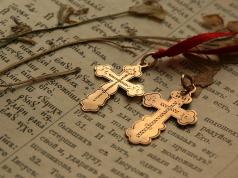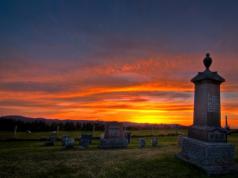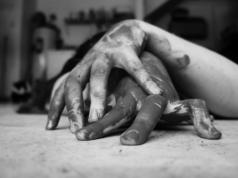Stages of paganism
- Stage 1 - Slavic ideas about ghouls and bereginyas
- Stage 2 - polytheism and subsequently the cult of Perun
- Yarilo
- Perun
- Svarog
- Veles
- Mokosh
- and etc.
- Goblin
- Brownie
- Water
- Bannik
- and etc.
- They (spirits) did not belong either to the underworld or to heaven, their place was next to people - in nearby forests, in plowed fields, in reservoirs familiar to everyone, in dwellings, courtyards, and outbuildings.
- If the power of the gods extended, according to pagan concepts, to the whole world, then evil spirits ruled in limited areas. The brownie had almost no power outside of “his” house; neither the goblin nor the merman left their possessions. But within these limits they had considerable power and could provide support to people or cause them harm.
- The spirit's place of residence is a remote forest slum, but sometimes a wasteland. However, this spirit does not live in the forest all the time, but only in the warm season. “On Erofey,” the peasants believed, “the goblin parted with the forest.” On this day, the spirit falls underground, where it hibernates until spring, but before wintering, the goblin goes berserk: it raises a storm, breaks trees, drives animals into their holes and goes berserk. According to Russian belief, the goblin loves to sit in the hollows of trees.
- Commands the mermaids. In general, he is kind, but sometimes the merman likes to play around and drag some unwary person to the bottom so that he entertains him. By the way, drowned people also serve in the service of the waterman.
- Related to home, family, household;
- Our ancestors could not imagine a home without a wonderful patron. Each dwelling had its own brownie. Each brownie lived on his own: the brownie neighbors were not friends, and were often at enmity.
- The appearance of the brownie was described in different ways. Most often he was depicted as a very old man with a gray beard. Usually the brownie looks like the owner of the house, and even wears the owner's clothes and adopts the owner's habits. The most extraordinary thing is the ability of a brownie to change his appearance: take the form of a cat, a dog, turn into a heap of hay or a bag of bread.
- The family, moving to a new house, had to take their brownie with them. Under no circumstances should it be allowed for another brownie to be in the new home,
- Bereginya is most often depicted as a young fair-haired girl in a simple light-colored dress. She always has a sad-kind expression on her face and is a little transparent, as befits a spirit. According to one version, Beregins become young girls who were betrothed, but died before marriage as a result of the machinations of evil forces.
- Bereginya is a positive character. This is clear even from her name, which clearly comes from the word “to protect.” Apparently, in the image of Bereginya, our distant ancestors hid a symbol of nature helping a worthy person fight evil. This is a kind and open image, thoroughly imbued with love. Birch and weeping willow are Beregini trees.
- Perun is, first of all, the god of thunder. In the Belarusian and Ukrainian languages, the word “Perun” means “thunder”, “thunder strike”. If lightning ignited a building, they said: “Perun burned it down.” It was impossible to put out such a fire. There is a well-known curse that circulated among the people: “May Perun kill you!”
- Patron of domestic animals. It was to him that one should turn to with requests for the well-being of livestock and to rid them of diseases. They sacrificed horses, bulls, and sheep to him. .
- In the 19th century in the south of Russia there was a custom: before the start of the harvest, old women in the field “curled Veles’s beard,” that is, without tearing the ears of grain out of the ground, they wove them into a knot and left them as a sign of hope for a rich harvest. According to other sources, they donated the last handful of ears of grain or the last sheaf to “Veles for the furrow.” This custom makes us look at Veles as a deity associated with agriculture, with hopes for a good harvest.
- Special people who directly communicated with the gods performed rituals
- Kolyada
- Maslenitsa
- Ivana Kupala
- In the Slavic calendar, major holidays were associated primarily with the circulation of the sun. The spring and autumn equinoxes, summer and winter solstices symbolized the cyclical nature of nature and the beginning of a new period in human life.
- Before the Baptism of Rus', Maslenitsa (Komoeditsa) was celebrated for 7 days preceding the day of the Spring Equinox, and 7 days after this day. Maslenitsa is the time when Nature awakens and the Sun-child Kolyada becomes the youth Yarila. The main attributes of Maslenitsa are pancakes and folk festivals. The ancients considered the pancake a symbol of the sun, since it, like the sun, is yellow, round and hot, and they believed that together with the pancake they eat a piece of its warmth and power. The last day of Maslenitsa is Forgiveness Sunday.
- The religious beliefs of our day are directly derived from the past. As you know, modern Orthodox Christianity in Russia is adjacent and intertwined with pagan beliefs and rituals, which are often performed by people who consider themselves true Christians.
- For example: leaving sweets, cookies and other food items at the grave of the deceased, a festive table with abundant food immediately after the burial of a person, arranged by his relatives and some other customs of the present time.
Religion of the Ancients
Slavs
I. N. Kozhevnikova
KGBPOU "ATT"
Barnaul

1 . Paganism and its characteristic features
3. Home perfume
5. Mythological creatures
6.Holidays of the ancient Slavs

Paganism - it is a system of primitive beliefs based on the deification of the environment and polytheism.

Characteristic features of paganism
polytheism – polytheism.
animism - belief in the existence of spirits.
totemism - an imaginary family union of a person with one or another natural object - a totem: an animal, a plant, an inanimate object, a natural phenomenon.
fetishism - worship of fetishes, i.e. inanimate objects endowed with supernatural properties.
magic - a set of rites and ritual practices that are based on the belief in the possibility of influencing people, animals and natural phenomena through supernatural forces.

ancestor cult
shamanism - a set of ideas and actions caused by belief in the ability of special persons (shamans, magicians) to be intermediaries between people and spirits
animation and personification of nature
cyclicality of consciousness - i.e. belief in the cycle of phenomena
mythical worldview - imagination of collective, national or individual fantasy, generally reflecting reality in the form of creatures that are refracted in consciousness as completely real.

Slavic
pantheon

Svarog - patron of the universe
Ruler of fire, blacksmithing, family hearth. Heavenly blacksmith and great warrior.
Svarog was the owner and keeper of the sacred fire and its creator.
It was Svarog who gave people pincers and taught them how to smelt copper and iron.

May God please Dazhd - god or Khors, Yarilo was the god of the Sun among the pagan Slavs.
His name means “giving God,” “giver of all blessings.”
The Slavs believed that Dazhd - God rides
across the sky in a wonderful chariot drawn by four white horses with golden wings.

Stribog - god of the wind.
Stribog can summon and tame a storm and can turn into his assistant, the mythical bird Stratim.
The sailors also prayed to Stribog to give “wind to the sail.”

Perun - the main god of the Eastern Slavs. Perun is, first of all, the god of thunder, thunder, and lightning.
Perun is considered the patron saint of warriors and knights.
He was glorified in the days of victory and sacrifices were made to him, wanting to achieve military success.

Genus - one of the gods, the embodiment of the clan, the unity of the descendants of one ancestor. Personified nature and harvest.
This cult was associated with the agricultural activities of the population and was therefore especially popular.
When a family wanted to have children, a special sacrifice was prepared for Rod - Having tasted this treat, Rod helped people

Veles - “cattle god”, patron of domestic animals, god of wealth, master’s wisdom.
He was a hunter and was perceived as a bear. It was believed that he contributed to enrichment. The holiday of Veles was celebrated in early January. For Veles of the day, special cookies were baked in the shape of pets. People dressed up in animal masks and put on inside-out sheepskin coats .

Makosh - the mother of all living things. She is the goddess of fate, the patroness of women and women's handicrafts - on Earth goddess of the harvest. the female deity, who personified the birth of all living things, was the patroness of the female part of the economy.
Guardian of female fertility and productivity, thriftiness and prosperity in the home.

Lada - mother of the gods, patroness of childbirth, women, children, marriage, love, harvest, fertility.
Lada was associated by the Slavs with the period of summer fertility, when the harvest ripens, becomes heavier, and becomes full. This is a respectable mistress of the house, the mother of a large family.
Lada was also considered the mother of the twelve months into which the year is divided.

"Home"
perfume

Brownie - the soul of the hut, the patron saint of the people living in it. The brownie is transported to a new house in a lapta. The spirit was closely associated with the cult of ancestors. He presented himself as a little old man with a face similar to the head of the family. By nature, he is an eternal troublemaker, grumpy, but caring and kind . The brownie's favorite animal is a cat.

Ovinnik -kept order in the barn
(barn)

Vazila - kept order in the barn.

Bannik - the spirit of the bathhouse, bringing people fainting and misfortune in the bathhouse. Favorite entertainment
tion - scald with boiling water. They cajoled him with a broom .

Brownie- the soul of the hut, the patron saint of the people living in it. The brownie is transported to a new house in a lapta. The cat was considered the brownie's favorite animal. The spirit of the Brownie was closely connected with the cult of ancestors.
Drum found in the mythologies of different peoples and in particular in Slavic mythology these are hooligan household spirits.
They fill the apartment with strange sounds, steal things; The matches refuse to light up, but for no apparent reason the boots blaze with a cheerful flame. Means drummer went hunting.

Spirits of the forests and
reservoirs

Goblin At the appointed hour of the full moon, On a par with the dark forest, - The prophetic rumor says, - Someone wanders in silence. Will the sexton pass on foot? Will the huntsman ride on horseback? Everyone who crosses himself says: “Devil I went on a bad spree!”

Water –– the evil spirit of rivers and lakes, the embodiment of the element of water. He is the owner of the sources. Lives most often in pools.

Kikimora-
evil spirit of the swamps

The Slavs believed that these were the souls of the dead coming out in the spring to enjoy nature.
The name "mermaid" comes from the word "blond", which means "light", "pure" in the ancient Slavic language. The habitat of mermaids was associated with the proximity of bodies of water - rivers, lakes, which were considered the path to the underworld. Along this waterway, mermaids came to land and lived on earth.

Brodnitsa –
indicated the crossing point .


Mythological creatures
Koschei the Deathless


Magi
magicians

Pagan holidays of the Slavs :
Martha)
Kolyada mid-January
solstice)
Apple Spas end of August
Autumn is the end of agricultural
works



“Life of the Slavs” - Activities of the Slavs. Perun is the god of thunder and lightning. History teacher Lapardina Olga Anatolyevna Municipal Educational Institution "Zlatorunovskaya Secondary School". 1-2 mistakes – score “5” 3-4 mistakes – score “4” 5-6 mistakes – score “3” 7 or more mistakes – score “2”. Slavic village. East Slavs. Southern. Real. Religious beliefs of the Slavs.
“Lada” - MBOU Toguchinsky district Gornovskaya secondary school teacher - Petrova Oksana Viktorovna. - Bless, mother, Oh, mother Lado, mother, call on spring! “We pray, Lada, we pray to the Almighty God. Let it blow, Lada, let the harvest rain fall, Oh, Lada, oh!” A holiday was dedicated to Lela - Lyalnik. The ladybug was associated with the Great Goddess, and later was an attribute of the Mother of God.
“Neighbors of the Eastern Slavs” - Algorithm for preparing for the presentation of material. Map "Neighbors of the Eastern Slavs." Lesson topic: “Neighbors of the Eastern Slavs.” Tribute is a natural or monetary collection from conquered tribes and peoples. Alas! Now let's answer the questions?! Consider the contents of the envelope. Which of the pictures below reveals the peculiarities of the life of the East Slavic tribes? 1 2 3.
“Life of the Slavs” - Ukrainians. Leshy. Agriculture. Mermaids. Belarusians. Sewing. Slavs. Gods. Hunting. Russians. Eastern. Water. Fishing. By the river. Beekeeping. Why? Settlement of the ancient Slavs. 2. Life itself demanded... unity. Perun. Perfume. Brownie. Gathering. Cooking food. Women. Western. Slavs
“Slavs” - The burial rite has always occupied a special place among the rites of the Slavs... Because of superstitions, bells were hung on clothes. Beekeeping also became widespread in Ancient Rus'. Slavic settlements. Religion of the Slavs. Economy of the Slavic tribes. There are up to 200 types of different types of pendants. A herd of cattle was the most important wealth of the Slavic community.
“The First Slavs” - 5. What did the word “Rus” mean among the Slavs? The first Russian chronicle of the monk Nestor. Pedigree – a list of generations of a family, establishing the origin and degree of relationship. Mirinskaya Natalya Alekseevna history teacher of school 232. Origin and settlement of the Slavs. 4. Neighbors of the Eastern Slavs: Khazars and Varangians.
There are a total of 23 presentations in the topic








